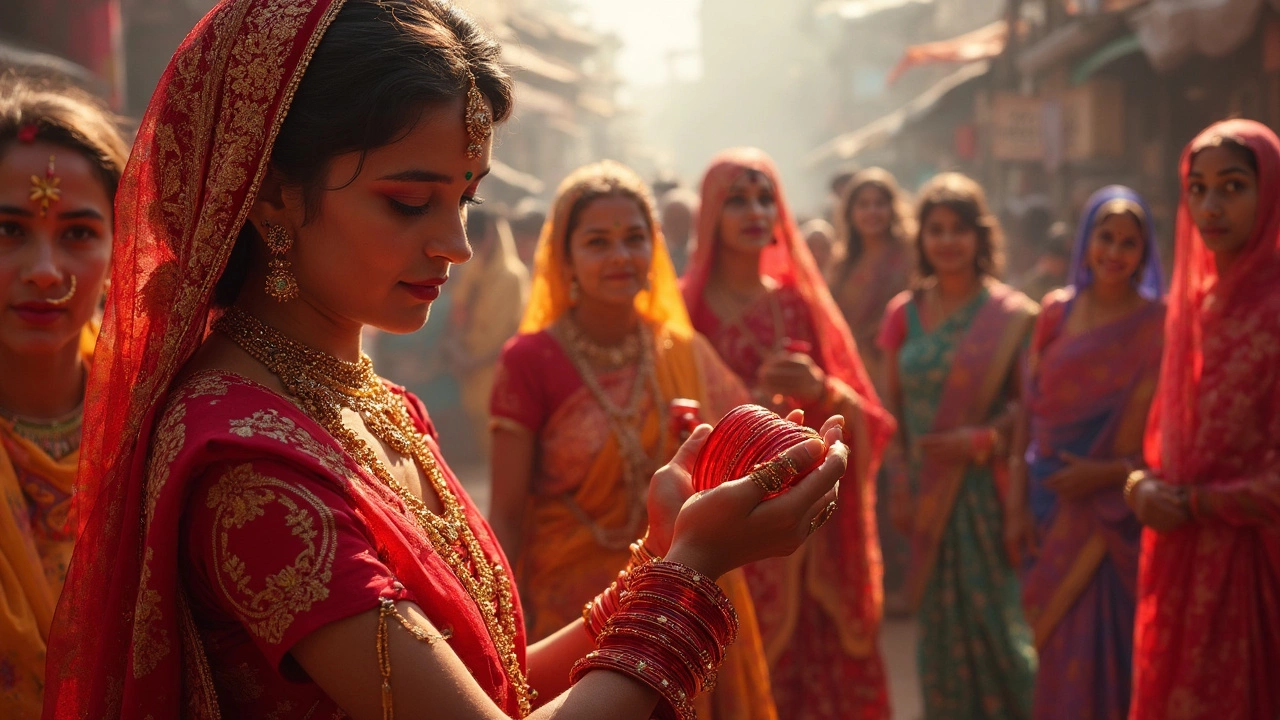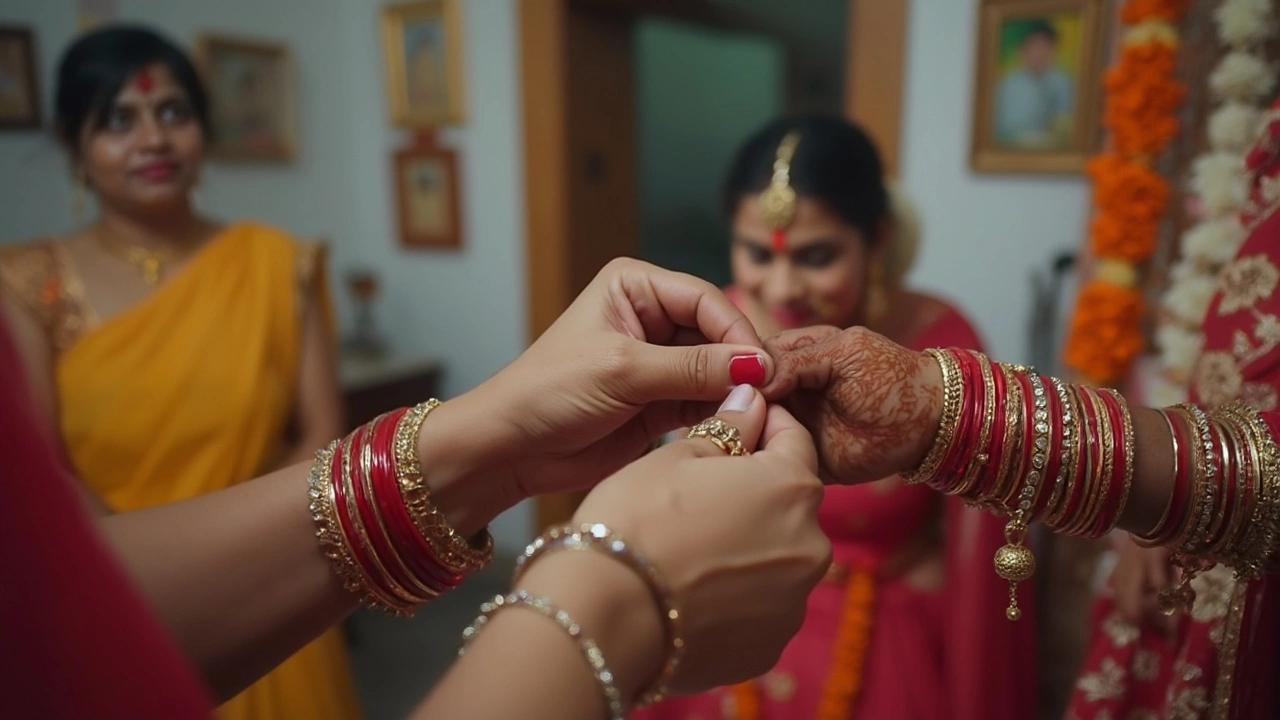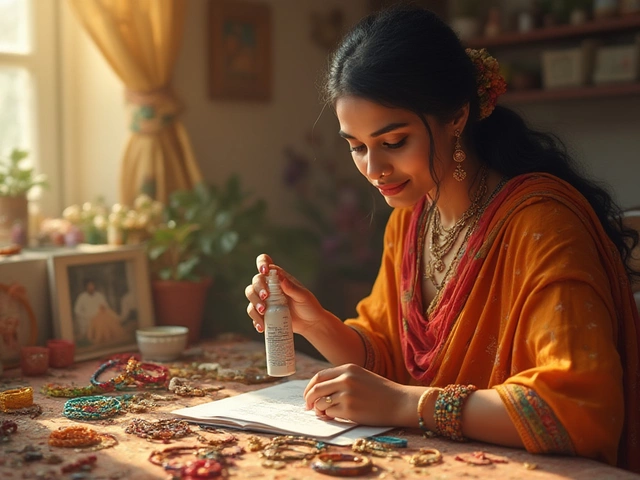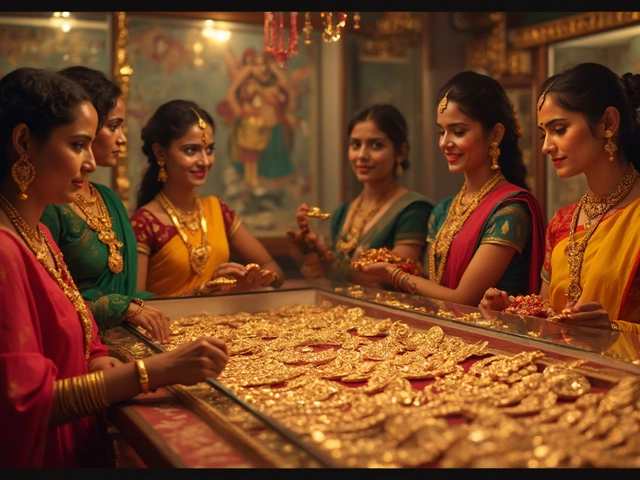
Ever noticed how every Indian bride flaunts a stack of bright red bangles at her wedding? Those bangles aren't just for show—they carry deep meaning and are packed with tradition. You might think it's just about fashion, but in India, red bangles tell a whole story at a glance.
So what's the big deal with the color red? In India, red isn't just eye-catching—it's loaded with symbolism. It stands for new beginnings, energy, and love, which is why you’ll spot it everywhere during weddings and festivals. Wearing red bangles sends a clear signal: the person is likely newly married or celebrating a big life event.
Red bangles aren't just about tradition; they also serve a social role. Spotting someone with red bangles gives you instant clues about their life stage or even which region they come from. Some people even believe that the sound of bangles clinking can bring good luck and keep away bad vibes.
- Why Red? The Color's Indian Significance
- A Must-Have for Weddings: Marriage and Red Bangles
- Regional Differences in Wearing Red Bangles
- Hidden Meanings: Beyond Love and Luck
- When and How to Wear Red Bangles
- Buying Guide: Picking the Right Red Bangles
Why Red? The Color's Indian Significance
Red in India isn’t just a color—it’s loaded with layers of meaning. From the moment you see a bride’s attire to the point she wears her first set of bangles, red keeps popping up. It’s no accident. Red is tied directly to feelings and events that matter most: marriage, love, and, yes, new beginnings.
People across India use red for anything big: it’s the main color at weddings, festivals like Holi, and even during the naming ceremonies of children. So why the obsession? Red is seen as a symbol of energy, purity, and strong emotions—the things you want more of in your life, especially at important moments. When anyone wears red bangles, it’s like waving a flag for good luck and a happy future.
Here’s a quick look at where red stands compared to other colors commonly worn in Indian traditions:
| Color | Typical Symbolism | Occasion Most Seen |
|---|---|---|
| Red | Marriage, power, love, good fortune | Weddings, festivals |
| Green | Fertility, growth, harmony | Engagements, daily wear |
| Yellow | Happiness, peace, purity | Religious events, poojas |
| White | Mourning, simplicity | Funerals, older widows |
Fun fact: In some regions, red powder called sindoor is applied to a bride's hair parting after marriage—a similar message as wearing red bangles. Both show that a woman is married and bring out that bold, auspicious energy everyone’s after.
No wonder people put so much weight on the color of their bangles. Red isn't just pretty—it’s meaningful and practically shouts, “Hey, something important is happening!” That’s why you’ll see red bangles at the center of so many Indian rituals and celebrations.
A Must-Have for Weddings: Marriage and Red Bangles
There’s no wedding in India without red bangles showing up front and center. For many, these bangles are as important as the wedding dress. They’re seen as a symbol of marriage and a public way to show off a new chapter in life. In Hindu weddings, the ritual of wearing red bangles is taken seriously. It’s not just about putting them on for a day—most brides wear them for weeks or even months after the big event.
Why such a fuss? In many communities, red bangles are believed to help bring good fortune and keep the couple together. There’s even an old-school belief that a bride should avoid breaking her red bangles, as it’s thought to bring bad luck. You’ll also find that the exact number and type of bangles can change from region to region or even depend on family tradition. Some go for a massive stack, while others prefer an even number on each wrist.
Here are some quick facts about red bangles in Indian weddings:
- The tradition is most common in North India but you’ll spot it almost everywhere.
- Bangles are usually made of glass, lac, or sometimes gold and other metals.
- During Punjabi weddings, the bride wears a special set called ‘Chooda’—thick ivory bangles with red on top—often gifted by her maternal uncle.
- Maharashtrian brides wear green with red, showing how different regions mix things up.
Check out how key details compare from place to place:
| Region | Bangle Type | When Worn |
|---|---|---|
| Punjab | Chooda (red & ivory) | Traditionally 40 days or more post-wedding |
| Gujarat | Red glass bangles | First few weeks after wedding |
| Maharashtra | Green and red (patlya) | Months after marriage |
In short, red bangles are a non-negotiable at Indian weddings. If you’re attending one or planning your own, skip them at your own risk—people will definitely notice!
Regional Differences in Wearing Red Bangles
You’d think red bangles mean the same thing everywhere in India, but that’s not the case. Each state puts its own spin on things, and the type or style of red bangles can tell you where someone comes from. Here’s what stands out across a few regions:
- Punjab: Brides here wear thick red and white bangles called chooda. The tradition says the bride should wear them for at least 40 days, some for even a year. Families often make a big celebration out of putting these bangles on.
- West Bengal: Women wear red (sometimes coral) and white bangles called shakha pola right after marriage. Their set includes a white bangle made from conch shells and a red one made from lac. Skipping these is almost unheard of for newlyweds here.
- Maharashtra: Red glass bangles called patlya and tode are the norm for married women. These are usually worn in odd numbers and are paired with green, which stands for fertility.
- South India: Red bangles aren’t always the lead role here; gold and green often take the spotlight. But red still shows up, especially during big life events or rituals.
- Rajasthan and Gujarat: You’ll spot red bangles made of ivory or lac, worn with other colors in striking combinations. Newlyweds often stick to red to signal their status.
To help make things even clearer, check out how regional styles stack up:
| Region | Main Red Bangle Custom | Common Material | Typical Duration Worn |
|---|---|---|---|
| Punjab | Chooda with white | Ivory/Plastic | 40 days to 1 year |
| West Bengal | Shakha Pola set with coral/red | Conch/lac/coral | After marriage, often lifelong |
| Maharashtra | Patlya and Tode | Glass/Gold | Daily for married women |
| Rajasthan, Gujarat | Ivory/Lac red bangles | Ivory/Lac | Special occasions or regular after wedding |
So, the next time you spot red bangles, you’ll know it’s not just about being married. They’re dropping hints about state pride, family customs, and how long someone’s been married. You’ll even find a few older women clinging to their bangles decades after marriage, just because it’s that meaningful where they’re from. For folks who want to really understand Indian traditions, checking out these bangle differences is way better than skimming a history book.

Hidden Meanings: Beyond Love and Luck
Everyone gets that red bangles are about romance and good fortune, but there’s more to the story. In many Indian homes, these bangles pack in layers of meaning that go way past just ‘you’re married now’ or wishing for a happy future.
For starters, many believe red bangles protect. They’re not magic, but some folks think bangles help keep negativity away, especially during big transitions like marriage. The tinkling of bangles isn’t just pretty—it’s said to signal positivity, keeping spirits up in the house. According to a survey from 2023 by India Today, almost 58% of Indian women said they felt a stronger sense of identity when wearing traditional red bangles.
Here’s where it gets interesting: red bangles can also hint at family status. Some families use a certain pattern or set number of bangles to show caste or community ties. This can tell locals a lot without anyone saying a word. Even the material matters. Glass bangles, especially in red, are considered lucky. But if one breaks, it’s seen as a warning—kind of an old-school superstition.
Check out this advice from the well-known Indian culture writer Meera Sanyal:
“Red bangles are not just about the obvious signs of marriage—they’re a link to ancestry and local customs. Even the way they’re worn has meaning in different states.”
Across India, some believe that wearing red bangles can boost health, especially for married women. This belief comes from the idea that bangles increase blood circulation as they press lightly on the wrist. True or not, it’s a fun fact that pops up often at family gatherings.
| Hidden Meaning | Where It’s Common | Notes |
|---|---|---|
| Protection from negativity | North & Central India | Popular during weddings and festivals |
| Showing family/caste ties | Across various regions | Specific bangle designs or number matter |
| Health and energy beliefs | South India | Bangles thought to boost blood flow |
| Breaking a red bangle as a warning | Pan-India | Considered bad luck by many elders |
All these hidden details add up. Spotting someone’s red bangles can tell you so much more than their relationship status—if you know what to look for.
When and How to Wear Red Bangles
There are clear rules and traditions around when you should wear red bangles in India. The most obvious time is right after a woman gets married. Red bangles pretty much announce that she's a newlywed, and in some regions, not wearing them during this period is a big deal.
Typically, a bride puts on her red bangles during a special ceremony either before or right after her wedding day. In North India, women often wear glass bangles, while in Maharashtra, you'll spot brides with green-and-red glass bangles called chooda. South Indian brides usually go with gold or red lac bangles, depending on local custom.
How long do women keep wearing red bangles? It varies—a lot. In Punjab, married women might wear them for a full year. In other places, it’s for a couple of months, or just until the honeymoon phase is over. Traditionally, taking them off once the set period is up is part of the ritual, often done in a family ceremony.
- For special festivals (like Karva Chauth or Teej), married women often stack on extra red bangles—even if their wedding was years ago.
- Some moms-to-be receive new red bangles during the baby shower ceremony, called ‘Godh Bharai’ in North India, for luck and safety.
- After the loss of a spouse, widows usually stop wearing red bangles. It’s a sensitive sign in many communities.
Want to wear red bangles in daily life? It’s fine, but many women pick lighter or fewer bangles for comfort at work. Real glass ones are a bit tricky—they break easily—so lots of women prefer plastic or metal versions for everyday use.
Here’s a snapshot of how long red bangles are worn in major regions:
| Region | Typical Duration |
|---|---|
| Punjab | 1 year |
| Maharashtra | Up to 8 months |
| Gujarat | About 6 months |
| South India | Varies: 40 days to 6 months |
One last tip: If you're gifting red bangles, double-check the right size (too tight is bad luck!) and, if possible, choose an even number. Odd numbers in a set can be seen as unlucky in some families.
Buying Guide: Picking the Right Red Bangles
Picking the right red bangles can feel tricky, especially when you're surrounded by so many options. Whether you're shopping for your own wedding or just curious about Indian tradition, there are a few things you need to keep in mind so you don't end up wasting money or buying the wrong kind.
First, check what material you want. Here’s a rundown to help you sort it out:
- Glass: Super traditional, affordable, and often used for big events, especially in North India. They’re fragile though, so be careful when wearing or stacking them.
- Plastic or Acrylic: Tougher and more flexible, these work well for everyday wear. They're also cheaper than metal bangles and come in a ton of designs.
- Lac: This is an old-school option, handmade and known for unique patterns. They can come with little stones or gold touches.
- Metal: Gold-plated or actual gold bangles look fancier, last longer, and are often given as gifts. Actual gold gets pricey fast, but a few thin gold bangles mixed with red ones is pretty common for brides.
Size matters, too. The wrong fit means discomfort or even injury since Indian bangles don’t flex much. Measure your hand at its widest point (usually with your thumb tucked in), or just try on a bunch at a local shop. If you're buying online, most shops list size charts—don’t skip this step.
Don’t forget about the meaning. In states like Punjab, the bridal set (called "chooda") is a combo of ivory or plastic with red. In Bengal, newlyweds often get a mix of red and white ("shankha pola"). The exact mix you're expected to wear depends on your background and family tradition.
If you’re shopping for a wedding ceremony, the bigger and brighter, the better. For daily use, pick lighter, thinner bangles—they won’t weigh your wrist down and blend better with regular outfits.
| Bangle Type | Durability | Traditional Use | Price Range (per dozen) |
|---|---|---|---|
| Glass | Fragile | Weddings, Festivals | ₹60-₹250 |
| Plastic/Acrylic | Very durable | Daily Wear | ₹40-₹120 |
| Lac | Medium | Special Occasions | ₹150-₹600 |
| Gold-plated | High | Gifting, Weddings | ₹400+ |
If you want to really nail it, bring along an aunt or elder—they know what’s expected and where to find bangles that match your outfit. No shame in asking! Mix and match sets are totally normal, so don’t stress too much about perfect matches. Buy a few extras just in case a glass one breaks—you’ll be glad you did.
Whether you’re after nostalgia or just like the look, shopping for red bangles is always more fun at a local market than a big-box chain. You’ll get better deals, more variety, and stories to go with them.


